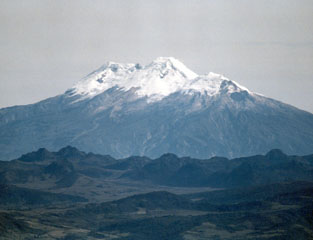Report on Nevado del Huila (Colombia) — 3 December-9 December 2008
Smithsonian Institution / US Geological Survey
Weekly Volcanic Activity Report, 3 December-9 December 2008
Managing Editor: Sally Sennert.
Please cite this report as:
Global Volcanism Program, 2008. Report on Nevado del Huila (Colombia) (Sennert, S, ed.). Weekly Volcanic Activity Report, 3 December-9 December 2008. Smithsonian Institution and US Geological Survey.
Nevado del Huila
Colombia
2.93°N, 76.03°W; summit elev. 5364 m
All times are local (unless otherwise noted)
INGEOMINAS reported that seismicity from Nevado del Huila continued to be elevated during 2-9 December. On 4 and 6 December overflights were conducted to view the new lava dome at the S flank of Pico Central. The dome elongated towards the SW of Pico Central, following the topography, and measured 400 m in the north-south direction, 150 m in the east-west direction, and was 120 m high. The approximate volume of the dome was 4,500,000 cubic meters. Gas plumes rose 1 km above the dome. New cracks in the glacier were also noted.
Geological Summary. Nevado del Huila, the highest peak in the Colombian Andes, is an elongated N-S-trending volcanic chain mantled by a glacier icecap. The andesitic-dacitic volcano was constructed within a 10-km-wide caldera. Volcanism at Nevado del Huila has produced six volcanic cones whose ages in general migrated from south to north. The high point of the complex is Pico Central. Two glacier-free lava domes lie at the southern end of the volcanic complex. The first historical activity was an explosive eruption in the mid-16th century. Long-term, persistent steam columns had risen from Pico Central prior to the next eruption in 2007, when explosive activity was accompanied by damaging mudflows.

